CNA342 Assessment 2: Clinical Scenario Report - Karam's Appendicitis
VerifiedAdded on 2022/11/12
|7
|2117
|89
Report
AI Summary
This report presents a case study of a 7-year-old boy named Karam who was diagnosed with appendicitis and admitted to a pediatric ward. The report provides an overview of the post-operative nursing care required, emphasizing pain management strategies, such as the use of pain scales and distraction techniques. It highlights the importance of child-centered care, considering the child's physical and cognitive perspectives, and the inclusion of the family in the care plan. The report also addresses communication challenges, particularly the language barrier between Karam's parents and the healthcare team, and suggests strategies for effective communication, including non-verbal cues and the implementation of family-centered care principles. The conclusion reiterates the need for comprehensive care that addresses the child's physical and emotional needs and ensures effective communication with the family to minimize complications and promote a positive recovery experience.
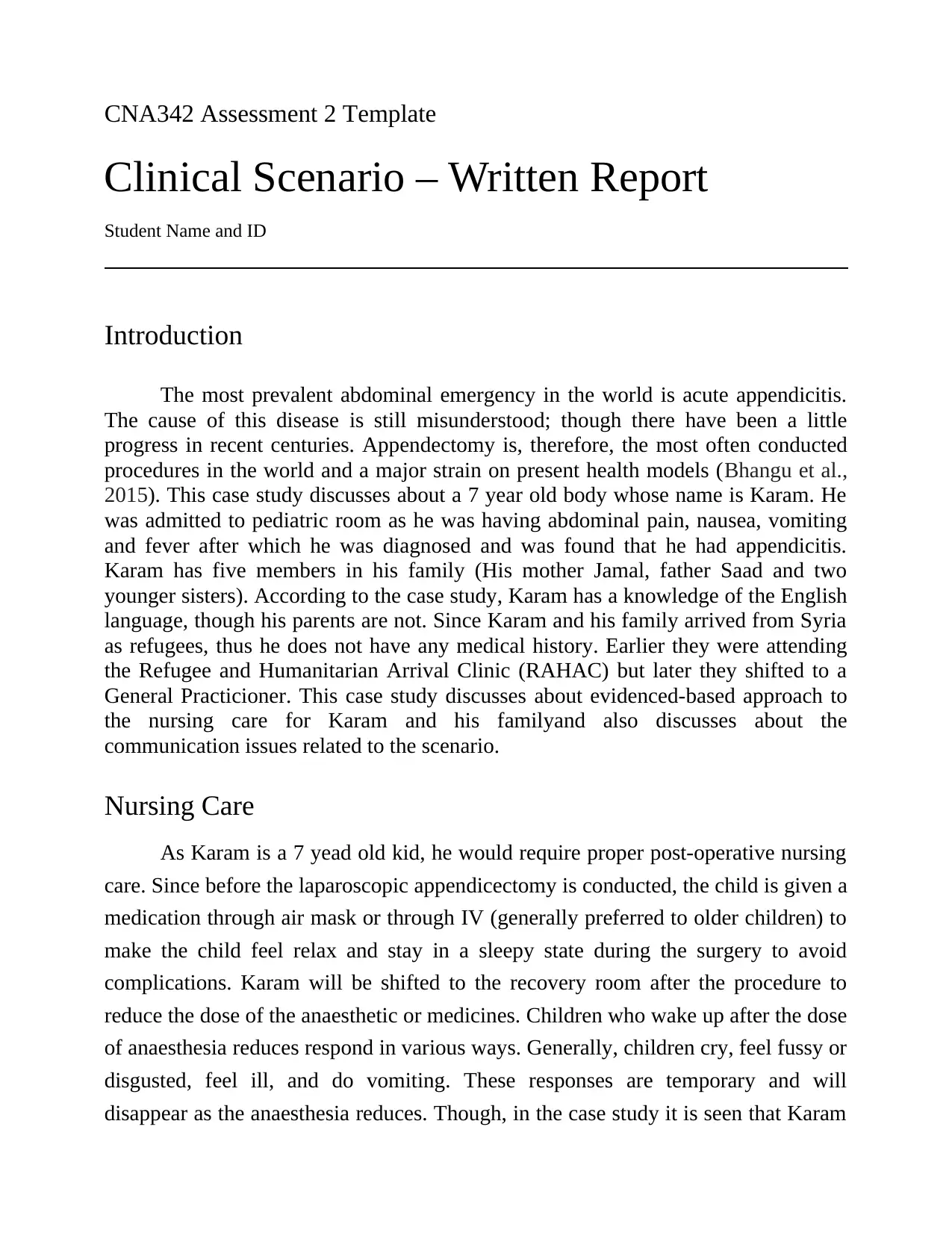
CNA342 Assessment 2 Template
Clinical Scenario – Written Report
Student Name and ID
Introduction
The most prevalent abdominal emergency in the world is acute appendicitis.
The cause of this disease is still misunderstood; though there have been a little
progress in recent centuries. Appendectomy is, therefore, the most often conducted
procedures in the world and a major strain on present health models (Bhangu et al.,
2015). This case study discusses about a 7 year old body whose name is Karam. He
was admitted to pediatric room as he was having abdominal pain, nausea, vomiting
and fever after which he was diagnosed and was found that he had appendicitis.
Karam has five members in his family (His mother Jamal, father Saad and two
younger sisters). According to the case study, Karam has a knowledge of the English
language, though his parents are not. Since Karam and his family arrived from Syria
as refugees, thus he does not have any medical history. Earlier they were attending
the Refugee and Humanitarian Arrival Clinic (RAHAC) but later they shifted to a
General Practicioner. This case study discusses about evidenced-based approach to
the nursing care for Karam and his familyand also discusses about the
communication issues related to the scenario.
Nursing Care
As Karam is a 7 yead old kid, he would require proper post-operative nursing
care. Since before the laparoscopic appendicectomy is conducted, the child is given a
medication through air mask or through IV (generally preferred to older children) to
make the child feel relax and stay in a sleepy state during the surgery to avoid
complications. Karam will be shifted to the recovery room after the procedure to
reduce the dose of the anaesthetic or medicines. Children who wake up after the dose
of anaesthesia reduces respond in various ways. Generally, children cry, feel fussy or
disgusted, feel ill, and do vomiting. These responses are temporary and will
disappear as the anaesthesia reduces. Though, in the case study it is seen that Karam
Clinical Scenario – Written Report
Student Name and ID
Introduction
The most prevalent abdominal emergency in the world is acute appendicitis.
The cause of this disease is still misunderstood; though there have been a little
progress in recent centuries. Appendectomy is, therefore, the most often conducted
procedures in the world and a major strain on present health models (Bhangu et al.,
2015). This case study discusses about a 7 year old body whose name is Karam. He
was admitted to pediatric room as he was having abdominal pain, nausea, vomiting
and fever after which he was diagnosed and was found that he had appendicitis.
Karam has five members in his family (His mother Jamal, father Saad and two
younger sisters). According to the case study, Karam has a knowledge of the English
language, though his parents are not. Since Karam and his family arrived from Syria
as refugees, thus he does not have any medical history. Earlier they were attending
the Refugee and Humanitarian Arrival Clinic (RAHAC) but later they shifted to a
General Practicioner. This case study discusses about evidenced-based approach to
the nursing care for Karam and his familyand also discusses about the
communication issues related to the scenario.
Nursing Care
As Karam is a 7 yead old kid, he would require proper post-operative nursing
care. Since before the laparoscopic appendicectomy is conducted, the child is given a
medication through air mask or through IV (generally preferred to older children) to
make the child feel relax and stay in a sleepy state during the surgery to avoid
complications. Karam will be shifted to the recovery room after the procedure to
reduce the dose of the anaesthetic or medicines. Children who wake up after the dose
of anaesthesia reduces respond in various ways. Generally, children cry, feel fussy or
disgusted, feel ill, and do vomiting. These responses are temporary and will
disappear as the anaesthesia reduces. Though, in the case study it is seen that Karam
Paraphrase This Document
Need a fresh take? Get an instant paraphrase of this document with our AI Paraphraser

is due pain relief. When he is qureid he states he feels fine, however, he lies on the
bed and crying. After that he is discharged back home. It is necessary for the nursing
team and surgical team to reduce the pain of the child to a minimum such that it does
not give rise to any complications in the distant future (Tallon et al., 2015).
Thus, to assess Karam’s pain after the post-operative procedure, his pain
should be assessed with the use of a pain scale. Through the result of pain scale only
the proper pain relief procedures can be administered. If Karam had a plain
appendectomy, the nurse should check the person for rehabilitation and establish a
plan regarding when they can eat and drink. The injury is to be aseptically handled.
The injury should be altered every 1-2 days when coated in a dry cloth. 10 days after
surgery, clips/stitches should be removed (Bloomer et al., 2015). According to many
researches children are usually very much encouraged in fun and sport activities.
Therefore, there might be a chance that after returning back from the surgery, Karam
might get hyped to participate in fun and sport activities. However, the surgeon
might restrict fun activities or any kind of sports unless suggested. Karam might be
encouraged for walking and stair climbing (Bloomer et al., 2015).
According to the child centred care, when treating a child, the doctor or the
nurse should not focus only on the child, rather they should also focus on the child’s
physical and cohnitive perspective also. Children should not be treated similarly like
adults. While treating a child, the nurse should also focus and be concerned about the
family (Hockenberry and Wilson, 2018). The nurse can implement distraction
approaches like, Karam can be provided with video games or any TV cartoon shows
for him to watch (Kenney and Milling, 2016). This will allow the nurse to effectively
assess the pain score of Karam and also provide the dressing change (Sahiner and
Bal, 2016). Health care professionals encourage self-assurance and service quality
by ensuring a family relationship with a strategy called family-centred care during
pediatric therapy. The professionals and organisations that adopt this ideology
encourage children's mental, physical, and cognitive wellness through therapy. This
strategy creates an atmosphere in which families are recognized as critical data
providers and a component of the care system (Hill, Knafl and Santacroce, 2018).
2
bed and crying. After that he is discharged back home. It is necessary for the nursing
team and surgical team to reduce the pain of the child to a minimum such that it does
not give rise to any complications in the distant future (Tallon et al., 2015).
Thus, to assess Karam’s pain after the post-operative procedure, his pain
should be assessed with the use of a pain scale. Through the result of pain scale only
the proper pain relief procedures can be administered. If Karam had a plain
appendectomy, the nurse should check the person for rehabilitation and establish a
plan regarding when they can eat and drink. The injury is to be aseptically handled.
The injury should be altered every 1-2 days when coated in a dry cloth. 10 days after
surgery, clips/stitches should be removed (Bloomer et al., 2015). According to many
researches children are usually very much encouraged in fun and sport activities.
Therefore, there might be a chance that after returning back from the surgery, Karam
might get hyped to participate in fun and sport activities. However, the surgeon
might restrict fun activities or any kind of sports unless suggested. Karam might be
encouraged for walking and stair climbing (Bloomer et al., 2015).
According to the child centred care, when treating a child, the doctor or the
nurse should not focus only on the child, rather they should also focus on the child’s
physical and cohnitive perspective also. Children should not be treated similarly like
adults. While treating a child, the nurse should also focus and be concerned about the
family (Hockenberry and Wilson, 2018). The nurse can implement distraction
approaches like, Karam can be provided with video games or any TV cartoon shows
for him to watch (Kenney and Milling, 2016). This will allow the nurse to effectively
assess the pain score of Karam and also provide the dressing change (Sahiner and
Bal, 2016). Health care professionals encourage self-assurance and service quality
by ensuring a family relationship with a strategy called family-centred care during
pediatric therapy. The professionals and organisations that adopt this ideology
encourage children's mental, physical, and cognitive wellness through therapy. This
strategy creates an atmosphere in which families are recognized as critical data
providers and a component of the care system (Hill, Knafl and Santacroce, 2018).
2
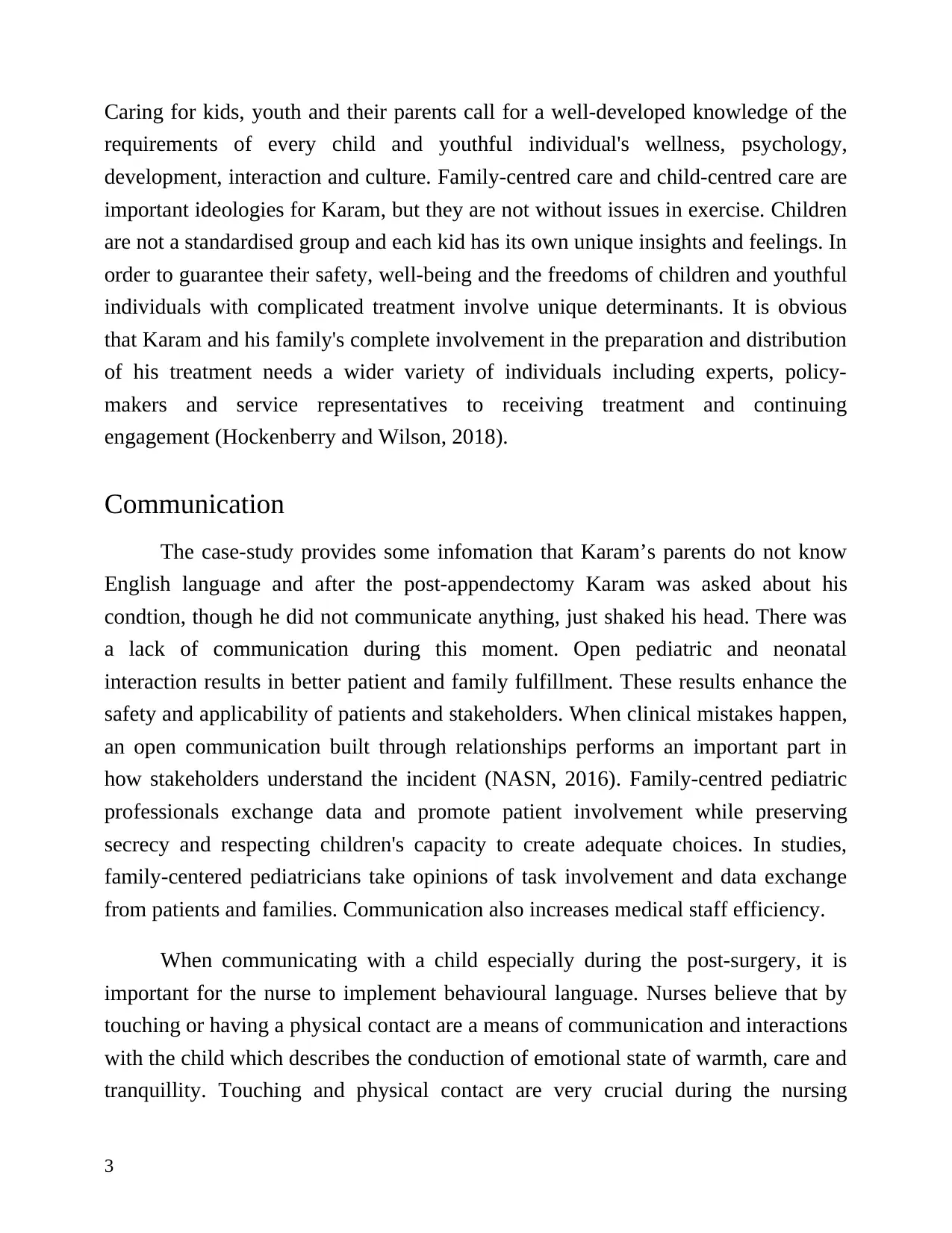
Caring for kids, youth and their parents call for a well-developed knowledge of the
requirements of every child and youthful individual's wellness, psychology,
development, interaction and culture. Family-centred care and child-centred care are
important ideologies for Karam, but they are not without issues in exercise. Children
are not a standardised group and each kid has its own unique insights and feelings. In
order to guarantee their safety, well-being and the freedoms of children and youthful
individuals with complicated treatment involve unique determinants. It is obvious
that Karam and his family's complete involvement in the preparation and distribution
of his treatment needs a wider variety of individuals including experts, policy-
makers and service representatives to receiving treatment and continuing
engagement (Hockenberry and Wilson, 2018).
Communication
The case-study provides some infomation that Karam’s parents do not know
English language and after the post-appendectomy Karam was asked about his
condtion, though he did not communicate anything, just shaked his head. There was
a lack of communication during this moment. Open pediatric and neonatal
interaction results in better patient and family fulfillment. These results enhance the
safety and applicability of patients and stakeholders. When clinical mistakes happen,
an open communication built through relationships performs an important part in
how stakeholders understand the incident (NASN, 2016). Family-centred pediatric
professionals exchange data and promote patient involvement while preserving
secrecy and respecting children's capacity to create adequate choices. In studies,
family-centered pediatricians take opinions of task involvement and data exchange
from patients and families. Communication also increases medical staff efficiency.
When communicating with a child especially during the post-surgery, it is
important for the nurse to implement behavioural language. Nurses believe that by
touching or having a physical contact are a means of communication and interactions
with the child which describes the conduction of emotional state of warmth, care and
tranquillity. Touching and physical contact are very crucial during the nursing
3
requirements of every child and youthful individual's wellness, psychology,
development, interaction and culture. Family-centred care and child-centred care are
important ideologies for Karam, but they are not without issues in exercise. Children
are not a standardised group and each kid has its own unique insights and feelings. In
order to guarantee their safety, well-being and the freedoms of children and youthful
individuals with complicated treatment involve unique determinants. It is obvious
that Karam and his family's complete involvement in the preparation and distribution
of his treatment needs a wider variety of individuals including experts, policy-
makers and service representatives to receiving treatment and continuing
engagement (Hockenberry and Wilson, 2018).
Communication
The case-study provides some infomation that Karam’s parents do not know
English language and after the post-appendectomy Karam was asked about his
condtion, though he did not communicate anything, just shaked his head. There was
a lack of communication during this moment. Open pediatric and neonatal
interaction results in better patient and family fulfillment. These results enhance the
safety and applicability of patients and stakeholders. When clinical mistakes happen,
an open communication built through relationships performs an important part in
how stakeholders understand the incident (NASN, 2016). Family-centred pediatric
professionals exchange data and promote patient involvement while preserving
secrecy and respecting children's capacity to create adequate choices. In studies,
family-centered pediatricians take opinions of task involvement and data exchange
from patients and families. Communication also increases medical staff efficiency.
When communicating with a child especially during the post-surgery, it is
important for the nurse to implement behavioural language. Nurses believe that by
touching or having a physical contact are a means of communication and interactions
with the child which describes the conduction of emotional state of warmth, care and
tranquillity. Touching and physical contact are very crucial during the nursing
3
⊘ This is a preview!⊘
Do you want full access?
Subscribe today to unlock all pages.

Trusted by 1+ million students worldwide
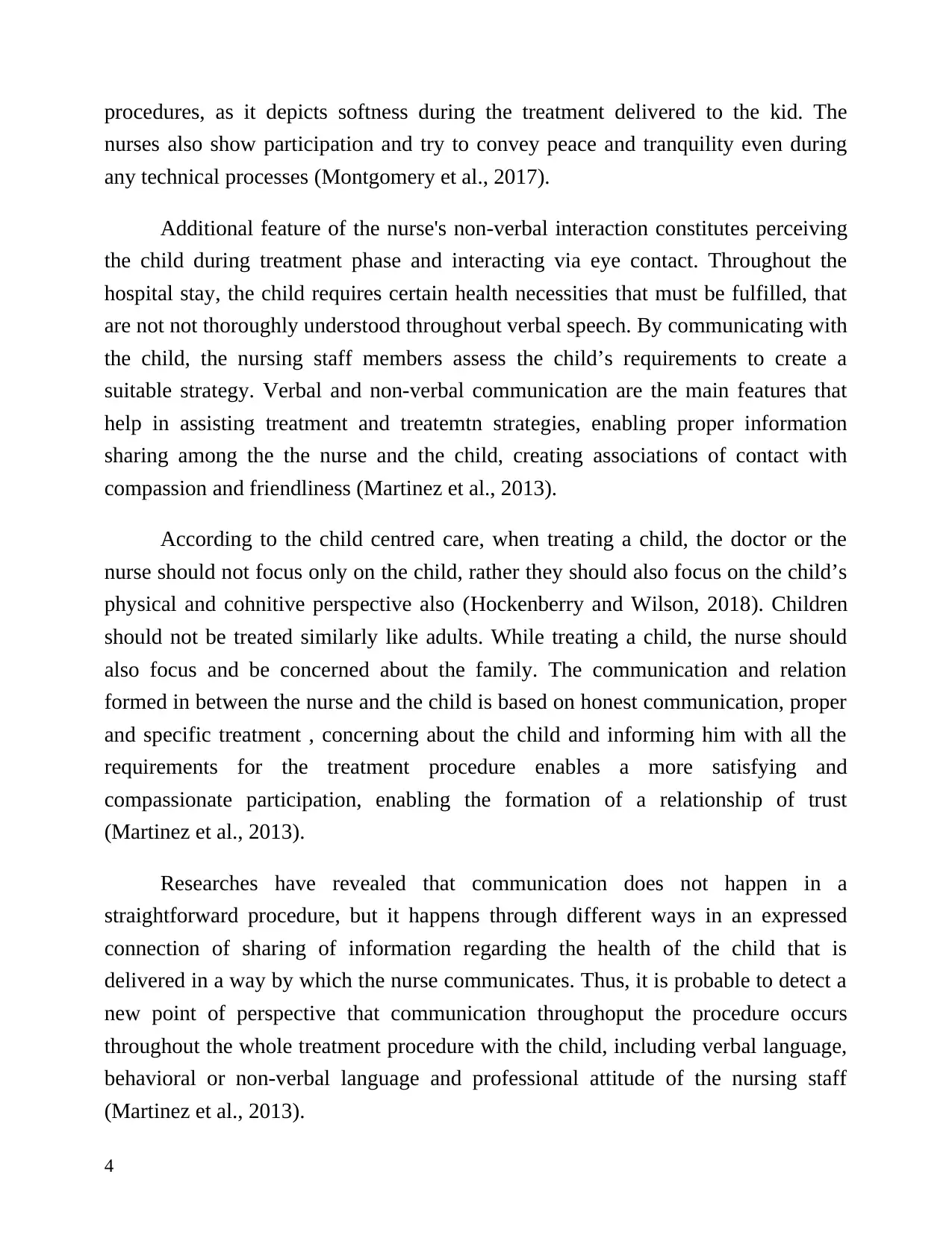
procedures, as it depicts softness during the treatment delivered to the kid. The
nurses also show participation and try to convey peace and tranquility even during
any technical processes (Montgomery et al., 2017).
Additional feature of the nurse's non-verbal interaction constitutes perceiving
the child during treatment phase and interacting via eye contact. Throughout the
hospital stay, the child requires certain health necessities that must be fulfilled, that
are not not thoroughly understood throughout verbal speech. By communicating with
the child, the nursing staff members assess the child’s requirements to create a
suitable strategy. Verbal and non-verbal communication are the main features that
help in assisting treatment and treatemtn strategies, enabling proper information
sharing among the the nurse and the child, creating associations of contact with
compassion and friendliness (Martinez et al., 2013).
According to the child centred care, when treating a child, the doctor or the
nurse should not focus only on the child, rather they should also focus on the child’s
physical and cohnitive perspective also (Hockenberry and Wilson, 2018). Children
should not be treated similarly like adults. While treating a child, the nurse should
also focus and be concerned about the family. The communication and relation
formed in between the nurse and the child is based on honest communication, proper
and specific treatment , concerning about the child and informing him with all the
requirements for the treatment procedure enables a more satisfying and
compassionate participation, enabling the formation of a relationship of trust
(Martinez et al., 2013).
Researches have revealed that communication does not happen in a
straightforward procedure, but it happens through different ways in an expressed
connection of sharing of information regarding the health of the child that is
delivered in a way by which the nurse communicates. Thus, it is probable to detect a
new point of perspective that communication throughoput the procedure occurs
throughout the whole treatment procedure with the child, including verbal language,
behavioral or non-verbal language and professional attitude of the nursing staff
(Martinez et al., 2013).
4
nurses also show participation and try to convey peace and tranquility even during
any technical processes (Montgomery et al., 2017).
Additional feature of the nurse's non-verbal interaction constitutes perceiving
the child during treatment phase and interacting via eye contact. Throughout the
hospital stay, the child requires certain health necessities that must be fulfilled, that
are not not thoroughly understood throughout verbal speech. By communicating with
the child, the nursing staff members assess the child’s requirements to create a
suitable strategy. Verbal and non-verbal communication are the main features that
help in assisting treatment and treatemtn strategies, enabling proper information
sharing among the the nurse and the child, creating associations of contact with
compassion and friendliness (Martinez et al., 2013).
According to the child centred care, when treating a child, the doctor or the
nurse should not focus only on the child, rather they should also focus on the child’s
physical and cohnitive perspective also (Hockenberry and Wilson, 2018). Children
should not be treated similarly like adults. While treating a child, the nurse should
also focus and be concerned about the family. The communication and relation
formed in between the nurse and the child is based on honest communication, proper
and specific treatment , concerning about the child and informing him with all the
requirements for the treatment procedure enables a more satisfying and
compassionate participation, enabling the formation of a relationship of trust
(Martinez et al., 2013).
Researches have revealed that communication does not happen in a
straightforward procedure, but it happens through different ways in an expressed
connection of sharing of information regarding the health of the child that is
delivered in a way by which the nurse communicates. Thus, it is probable to detect a
new point of perspective that communication throughoput the procedure occurs
throughout the whole treatment procedure with the child, including verbal language,
behavioral or non-verbal language and professional attitude of the nursing staff
(Martinez et al., 2013).
4
Paraphrase This Document
Need a fresh take? Get an instant paraphrase of this document with our AI Paraphraser
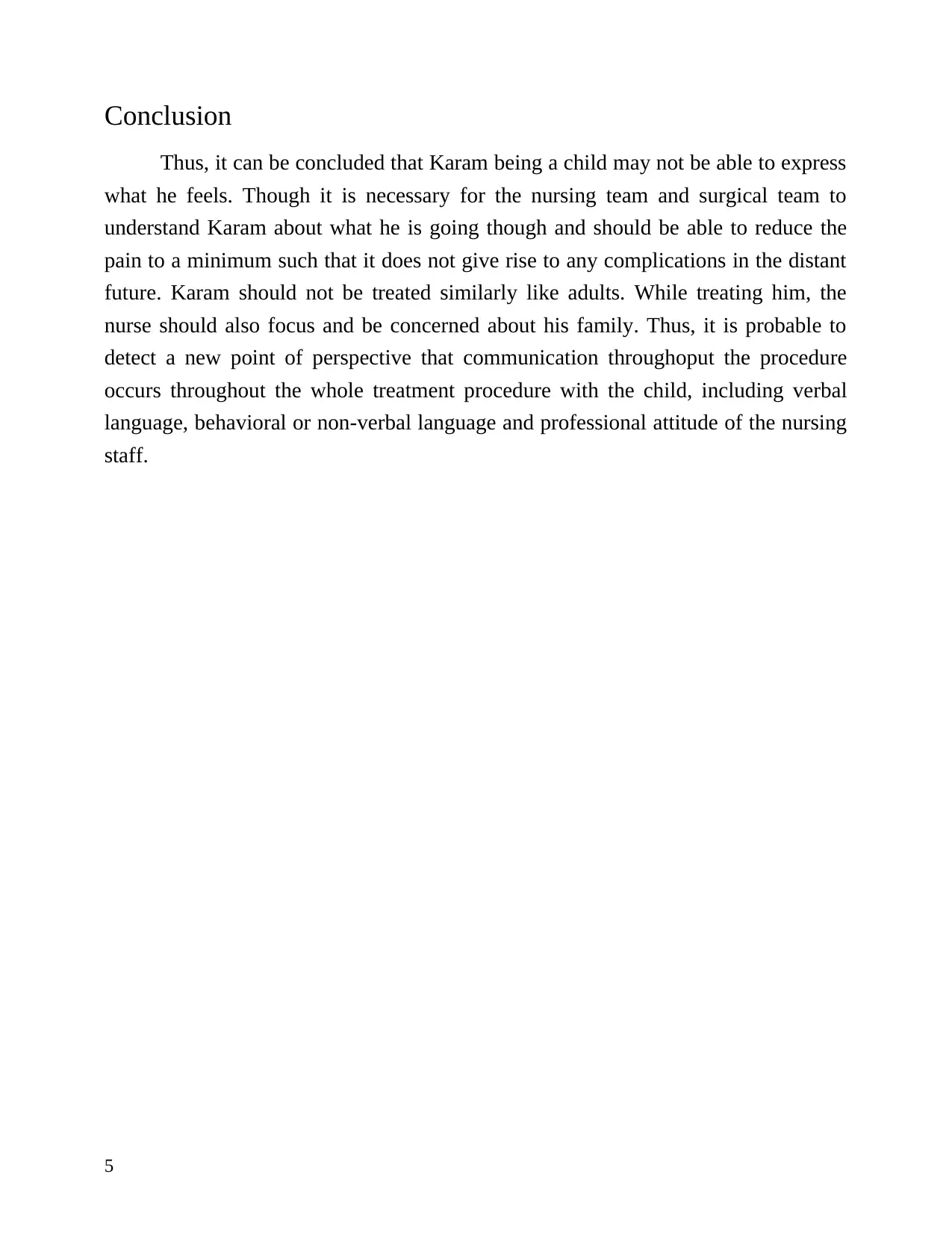
Conclusion
Thus, it can be concluded that Karam being a child may not be able to express
what he feels. Though it is necessary for the nursing team and surgical team to
understand Karam about what he is going though and should be able to reduce the
pain to a minimum such that it does not give rise to any complications in the distant
future. Karam should not be treated similarly like adults. While treating him, the
nurse should also focus and be concerned about his family. Thus, it is probable to
detect a new point of perspective that communication throughoput the procedure
occurs throughout the whole treatment procedure with the child, including verbal
language, behavioral or non-verbal language and professional attitude of the nursing
staff.
5
Thus, it can be concluded that Karam being a child may not be able to express
what he feels. Though it is necessary for the nursing team and surgical team to
understand Karam about what he is going though and should be able to reduce the
pain to a minimum such that it does not give rise to any complications in the distant
future. Karam should not be treated similarly like adults. While treating him, the
nurse should also focus and be concerned about his family. Thus, it is probable to
detect a new point of perspective that communication throughoput the procedure
occurs throughout the whole treatment procedure with the child, including verbal
language, behavioral or non-verbal language and professional attitude of the nursing
staff.
5

REFERENCES
Bhangu, A., Søreide, K., Di Saverio, S., Assarsson, J.H. and Drake, F.T., 2015.
Acute appendicitis: modern understanding of pathogenesis, diagnosis, and
management. The Lancet, 386(10000), pp.1278-1287.
Martinez, E.A., Tocantins, F.R. and Souza, S.R.D., 2013. The specificities of
communication in child nursing care. Revista Gaucha de enfermagem, 34(1), pp.37-
44.
Hockenberry, M.J. and Wilson, D., 2018. Wong's nursing care of infants and
children-E-book. Elsevier Health Sciences.
Hill, C., Knafl, K.A. and Santacroce, S.J., 2018. Family-centered care from the
perspective of parents of children cared for in a pediatric intensive care unit: an
integrative review. Journal of pediatric nursing, 41, pp.22-33.
Montgomery, K.E., Sawin, K.J. and Hendricks-Ferguson, V., 2017. Communication
during palliative care and end of life: Perceptions of experienced pediatric oncology
nurses. Cancer nursing, 40(2), pp.E47-E57.
Tallon, M.M., Kendall, G.E. and Snider, P.D., 2015. Rethinking family‐centred care
for the child and family in hospital. Journal of Clinical Nursing, 24(9-10), pp.1426-
1435.
Bloomer, M.J., O’Connor, M., Copnell, B. and Endacott, R., 2015. Nursing care for
the families of the dying child/infant in paediatric and neonatal ICU: nurses’
emotional talk and sources of discomfort. A mixed methods study. Australian
Critical Care, 28(2), pp.87-92.
National Association of School Nurses, 2016. Framework for 21st century school
nursing practice: National Association of School Nurses. NASN School Nurse,
31(1), pp.45-53.
6
Bhangu, A., Søreide, K., Di Saverio, S., Assarsson, J.H. and Drake, F.T., 2015.
Acute appendicitis: modern understanding of pathogenesis, diagnosis, and
management. The Lancet, 386(10000), pp.1278-1287.
Martinez, E.A., Tocantins, F.R. and Souza, S.R.D., 2013. The specificities of
communication in child nursing care. Revista Gaucha de enfermagem, 34(1), pp.37-
44.
Hockenberry, M.J. and Wilson, D., 2018. Wong's nursing care of infants and
children-E-book. Elsevier Health Sciences.
Hill, C., Knafl, K.A. and Santacroce, S.J., 2018. Family-centered care from the
perspective of parents of children cared for in a pediatric intensive care unit: an
integrative review. Journal of pediatric nursing, 41, pp.22-33.
Montgomery, K.E., Sawin, K.J. and Hendricks-Ferguson, V., 2017. Communication
during palliative care and end of life: Perceptions of experienced pediatric oncology
nurses. Cancer nursing, 40(2), pp.E47-E57.
Tallon, M.M., Kendall, G.E. and Snider, P.D., 2015. Rethinking family‐centred care
for the child and family in hospital. Journal of Clinical Nursing, 24(9-10), pp.1426-
1435.
Bloomer, M.J., O’Connor, M., Copnell, B. and Endacott, R., 2015. Nursing care for
the families of the dying child/infant in paediatric and neonatal ICU: nurses’
emotional talk and sources of discomfort. A mixed methods study. Australian
Critical Care, 28(2), pp.87-92.
National Association of School Nurses, 2016. Framework for 21st century school
nursing practice: National Association of School Nurses. NASN School Nurse,
31(1), pp.45-53.
6
⊘ This is a preview!⊘
Do you want full access?
Subscribe today to unlock all pages.

Trusted by 1+ million students worldwide
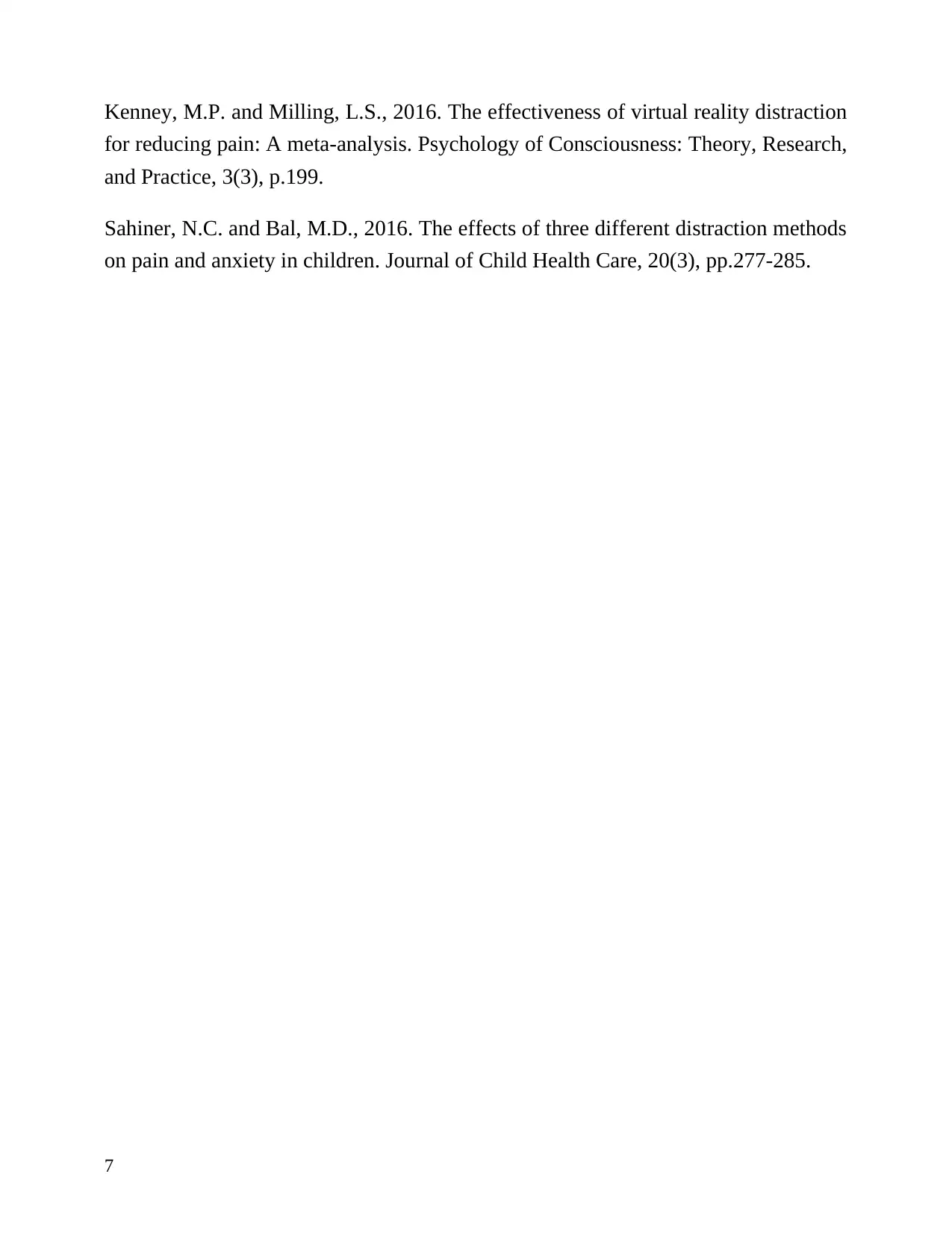
Kenney, M.P. and Milling, L.S., 2016. The effectiveness of virtual reality distraction
for reducing pain: A meta-analysis. Psychology of Consciousness: Theory, Research,
and Practice, 3(3), p.199.
Sahiner, N.C. and Bal, M.D., 2016. The effects of three different distraction methods
on pain and anxiety in children. Journal of Child Health Care, 20(3), pp.277-285.
7
for reducing pain: A meta-analysis. Psychology of Consciousness: Theory, Research,
and Practice, 3(3), p.199.
Sahiner, N.C. and Bal, M.D., 2016. The effects of three different distraction methods
on pain and anxiety in children. Journal of Child Health Care, 20(3), pp.277-285.
7
1 out of 7
Related Documents
Your All-in-One AI-Powered Toolkit for Academic Success.
+13062052269
info@desklib.com
Available 24*7 on WhatsApp / Email
![[object Object]](/_next/static/media/star-bottom.7253800d.svg)
Unlock your academic potential
Copyright © 2020–2025 A2Z Services. All Rights Reserved. Developed and managed by ZUCOL.




